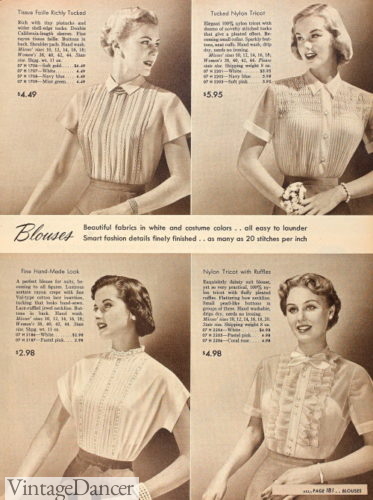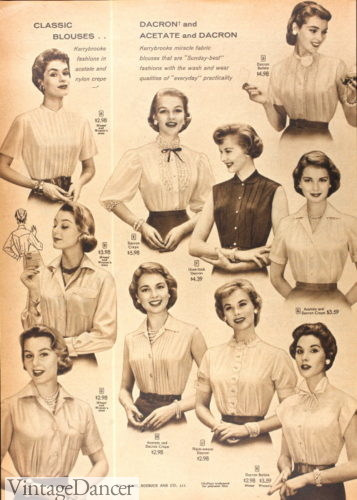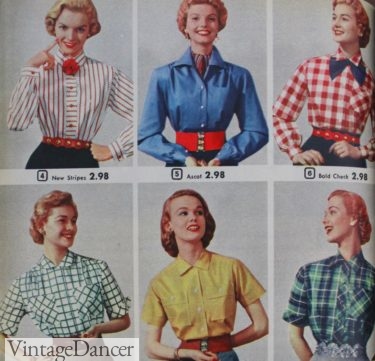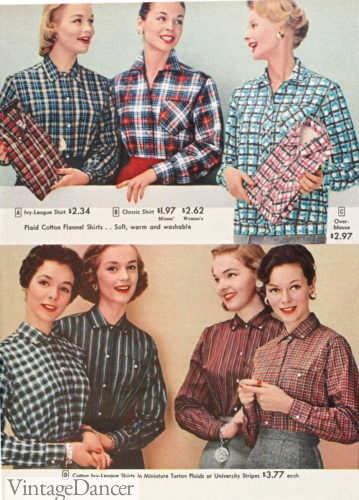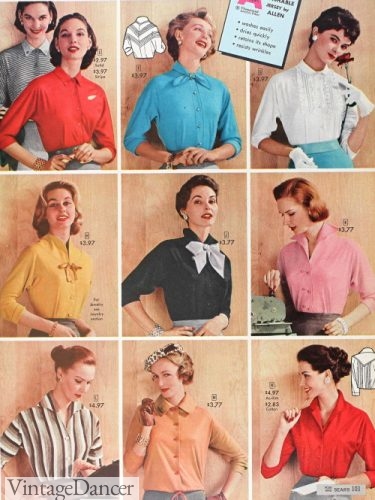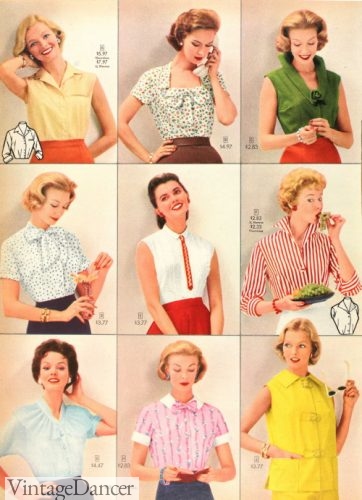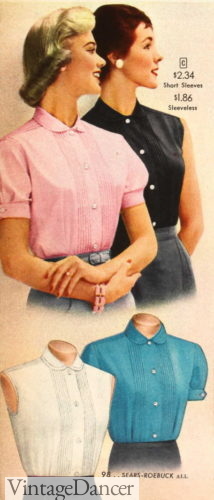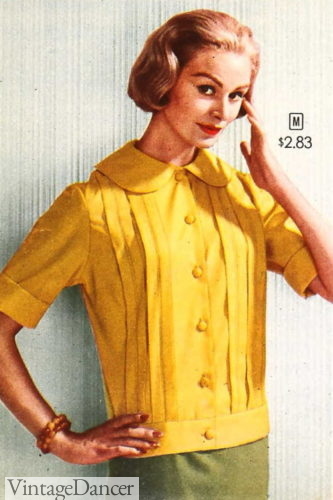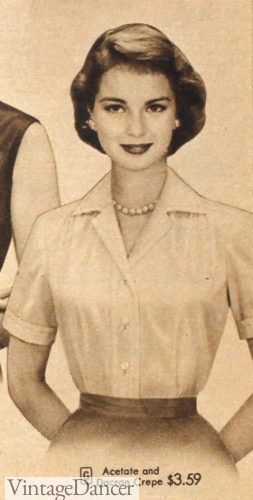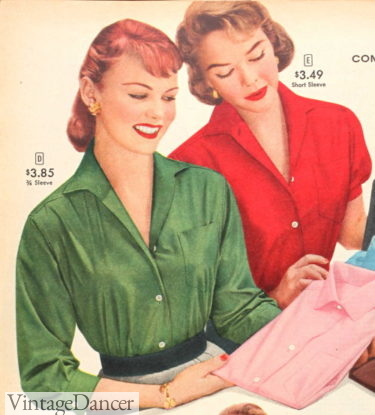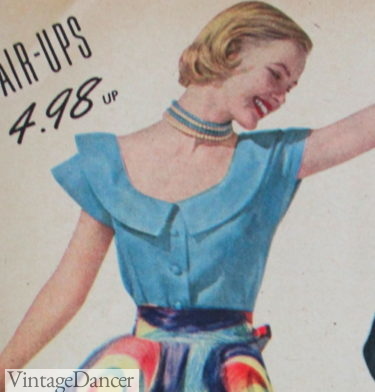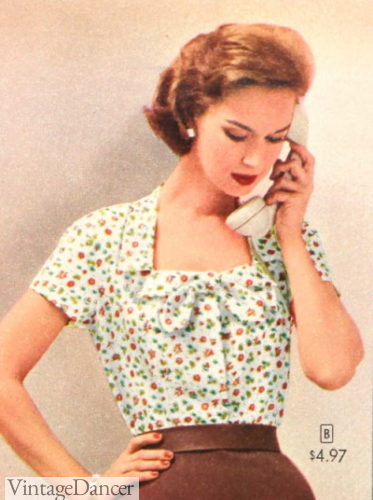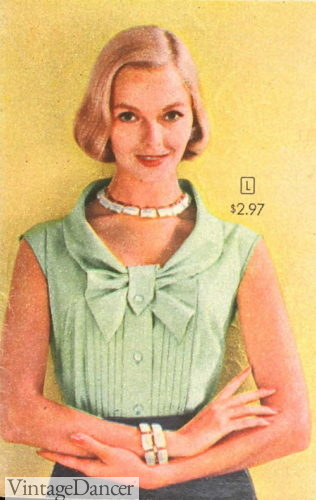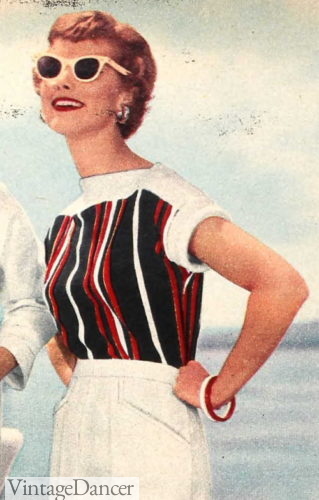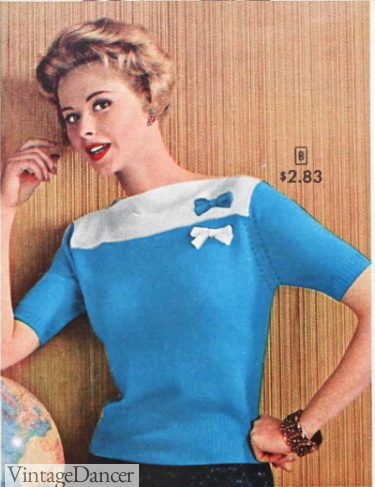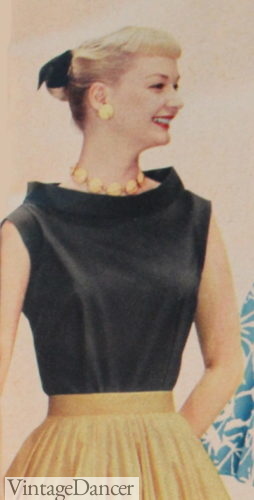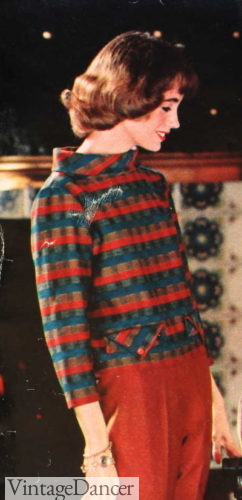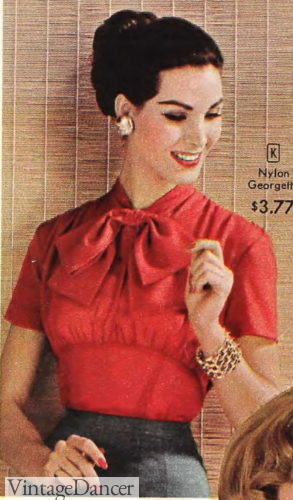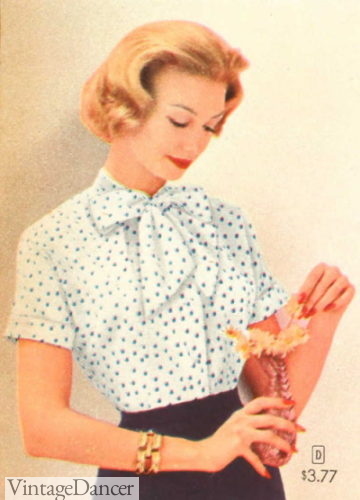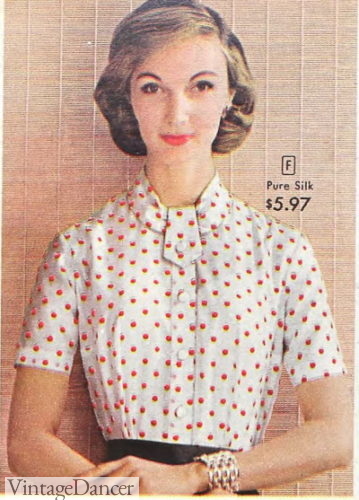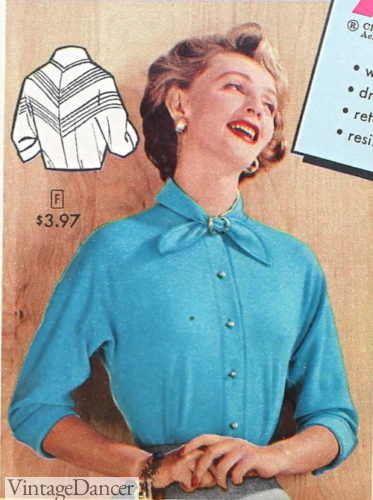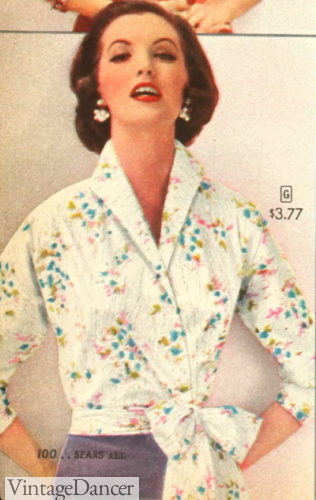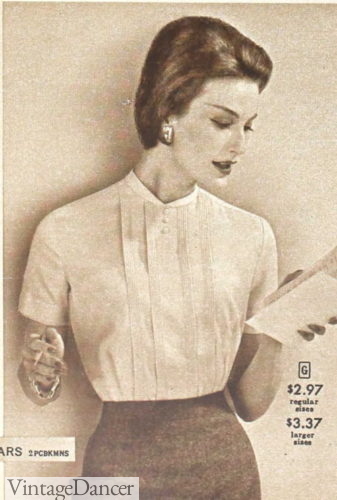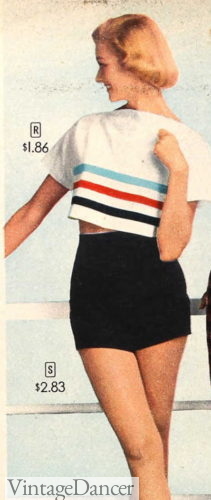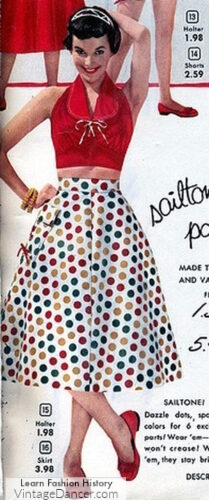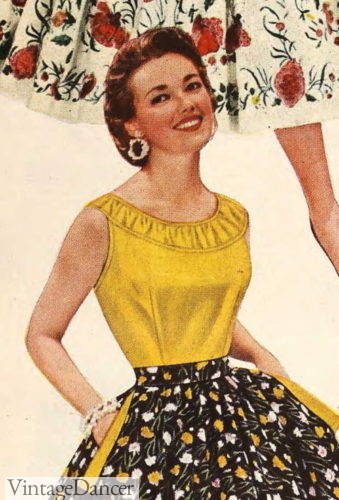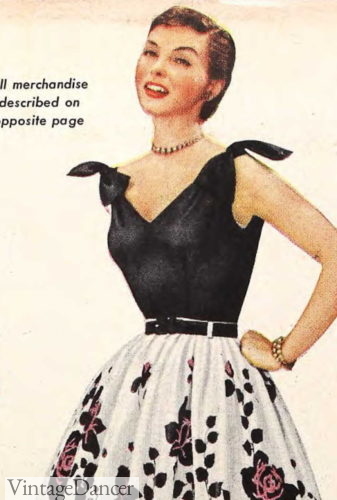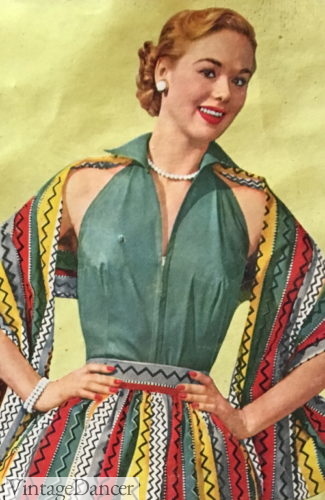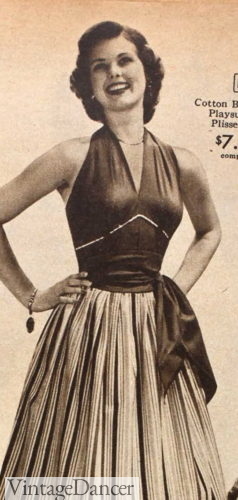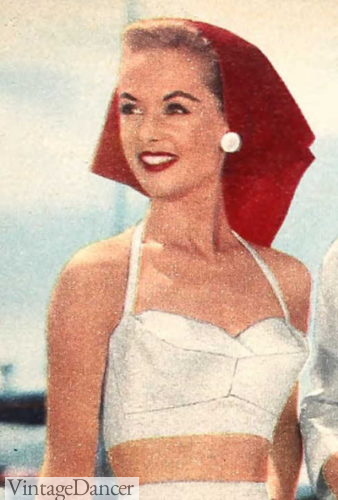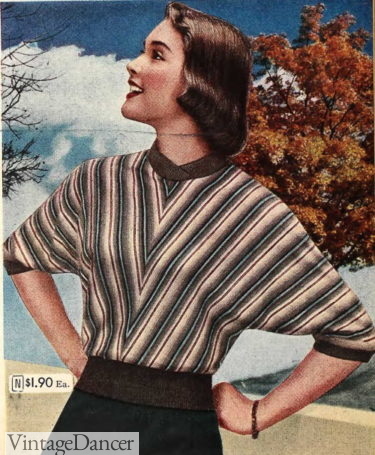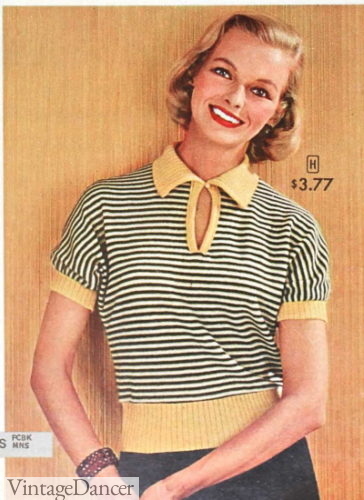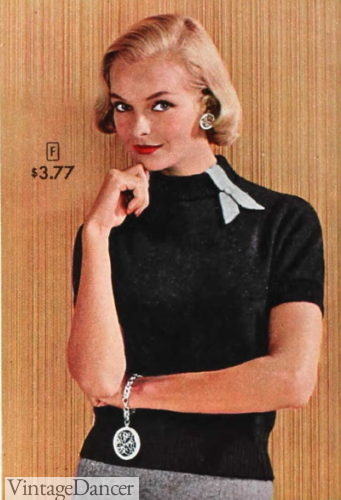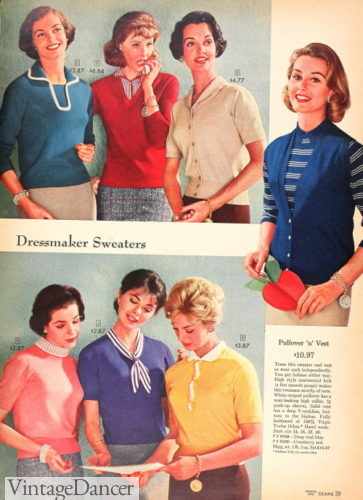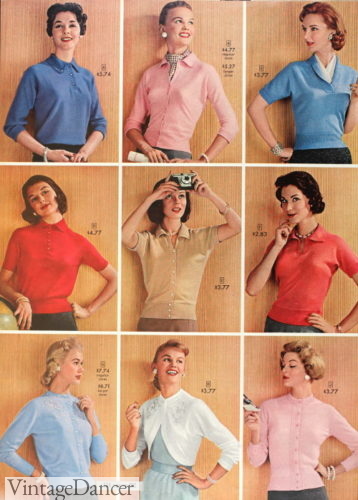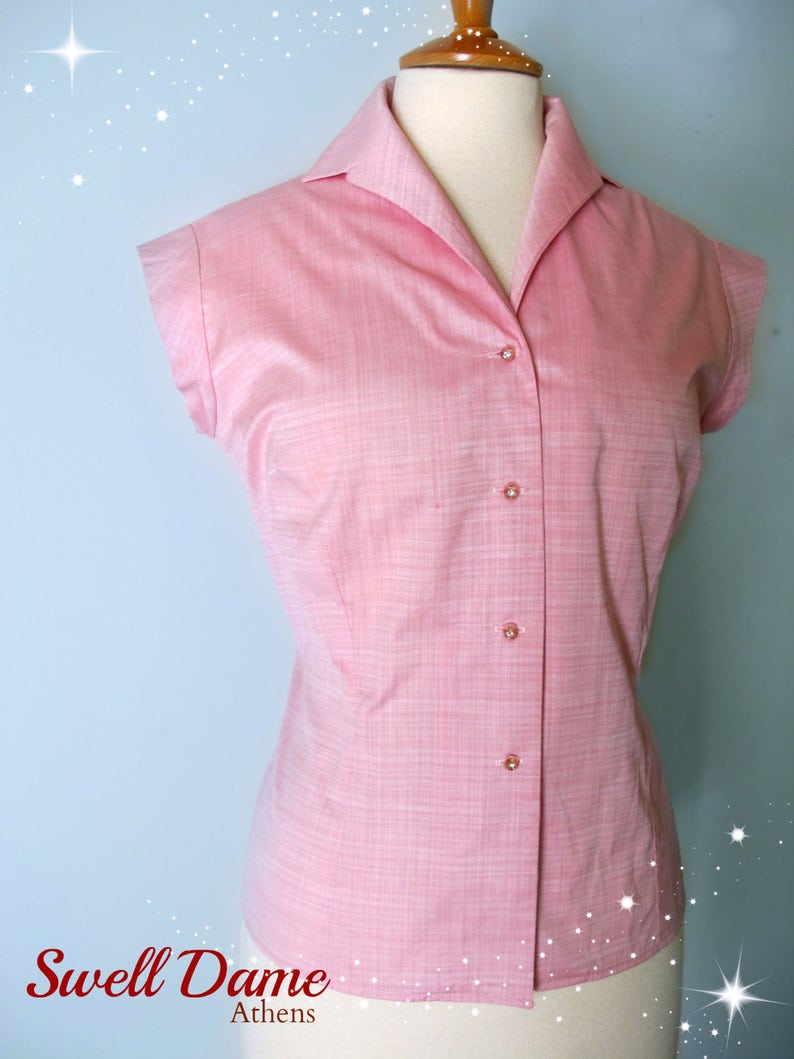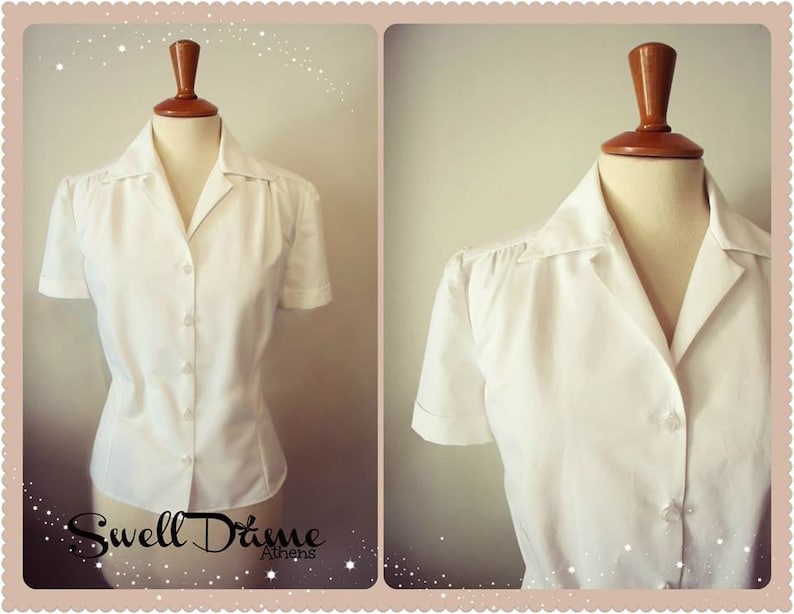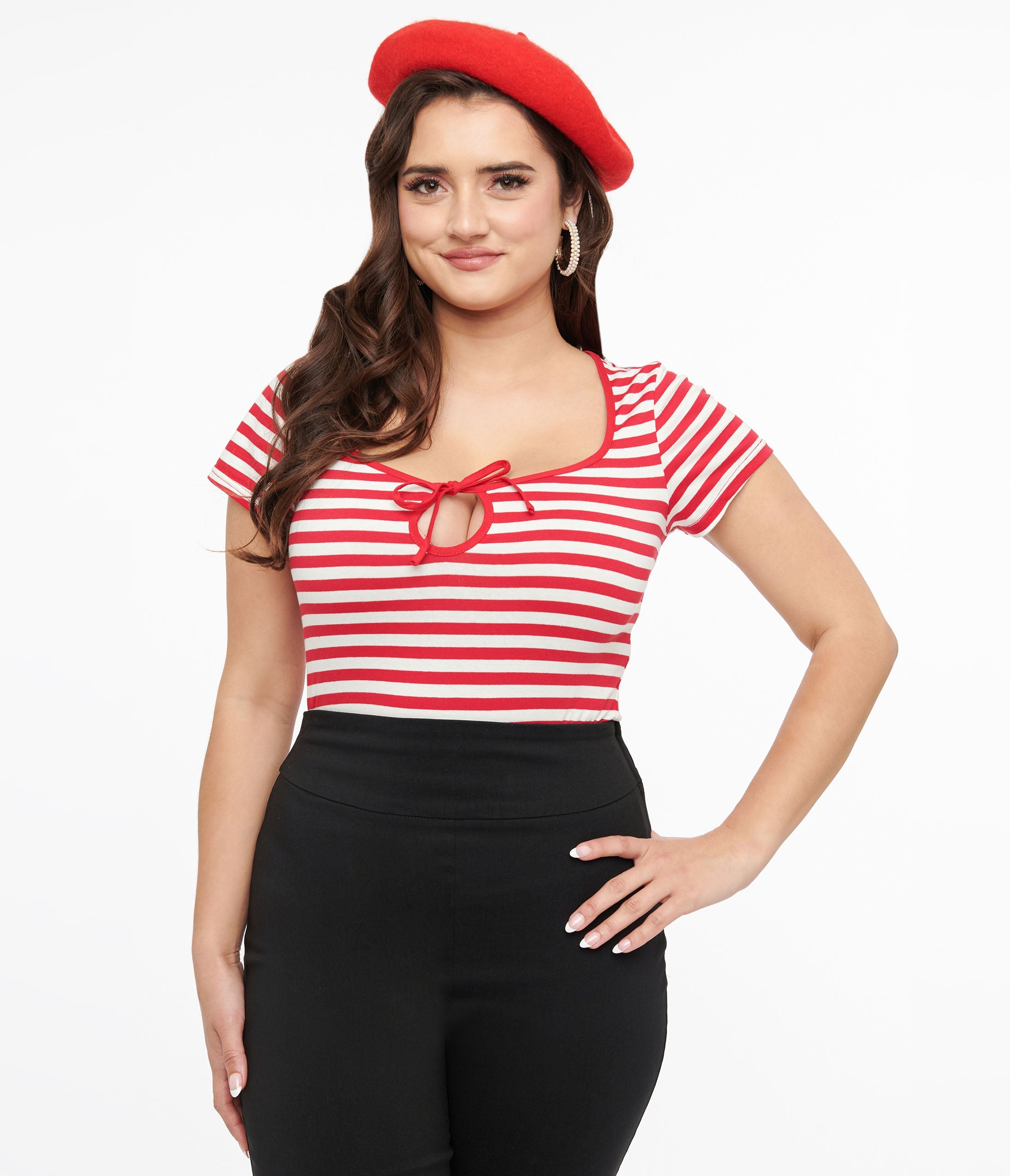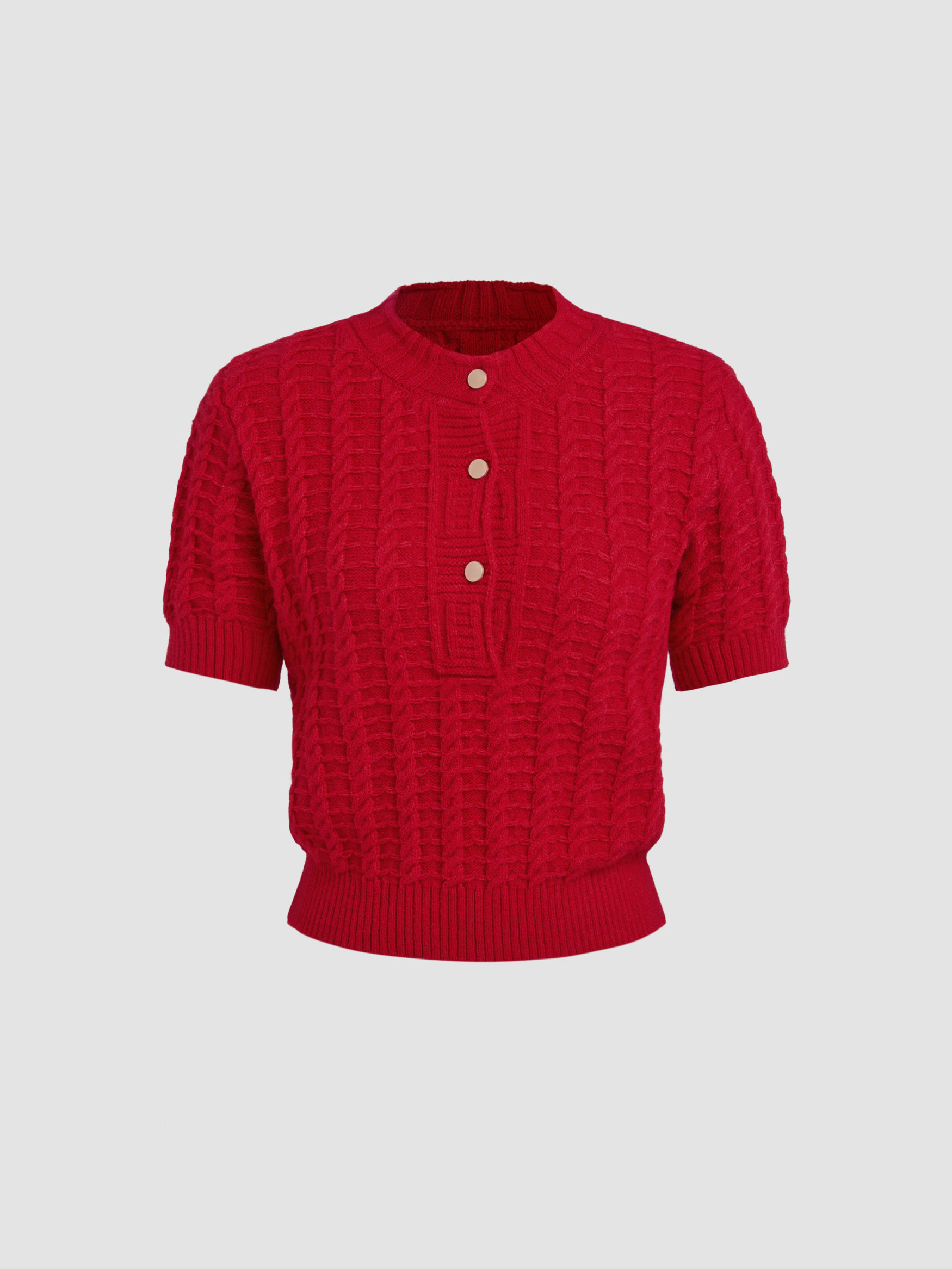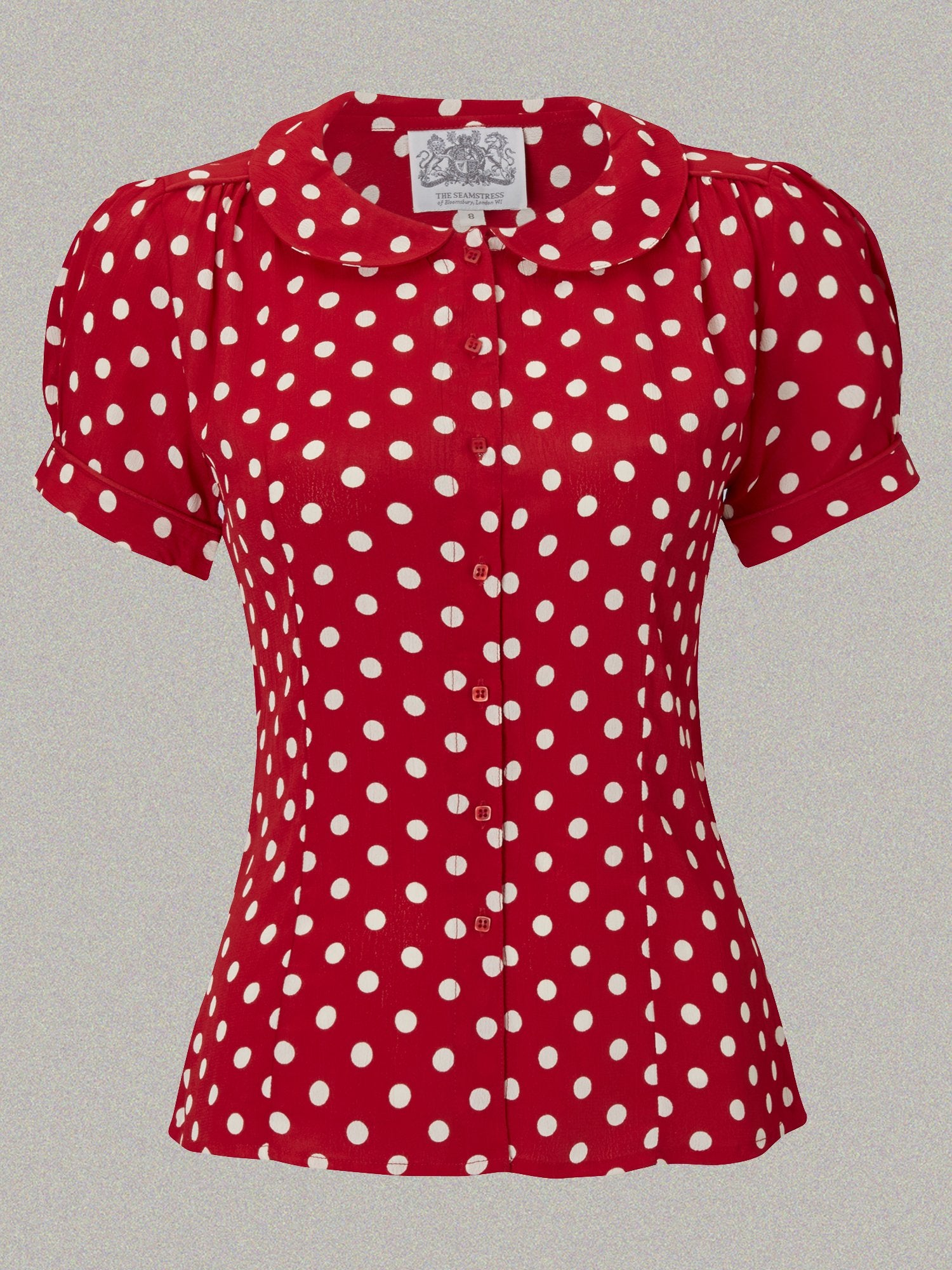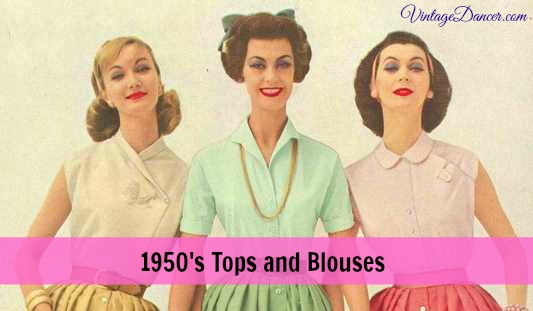
Mixing separates was an especially exciting idea in the ’50s. With an explosion of new styles, synthetic materials, and affordable prices, women bought up 1950s tops and bottoms in record numbers. It was advised to purchase several shirts in the same style so that a woman always had coordinating outfits.
In the 1940s, blouses were almost always white or ivory, but color was in style in the ’50s. They either matched the bottoms or added a bright splash of color against a neutral pant or skirt. Feminine ruffles and lace blouses in the early years were replaced by man-tailored button down shirts that accented a woman’s waist and gave her an overall more casual look.
Shop 1950s style tops and shirts here.
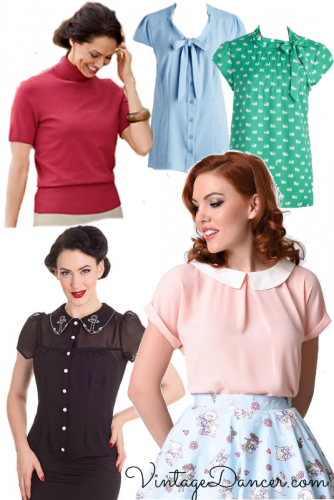
Shop 1950s style tops, blouses, shirts, knitwear
1950s Shirts, Tops, Blouses
Shirts, blouses, tops, whatever you want to call them, were worn with skirts, pants, and shorts. They were fitted to the waist, but not tight. Sleeves came in long, short, cap sleeves, or were sleeveless. The puffy sleeve of the 1940s blouse went out of fashion for a less fussy straight fitting sleeve, sometimes with a narrow cuff by the mid 1950s.
Classic white blouses were adorned in mini frills, ruffles, and pleats. Teenagers called them “Sissy blouses.” The matador blouse had a bib of small ruffles. Bows were a popular decoration as well as narrow pintuck pleating in the early years. Buttons were small and usually either plain white or had a pearl finish on fancier styles.
- 1952 White Blouses
- 1956 White Blouses
While the 1940s borrowed elements from men’s military uniforms for women’s suits and dresses, the 1950s borrowed men’s dress shirts for their own tops. At first, teens literally borrowed Dad’s old shirts to wear as a cover up while washing the car or digging in the garden. They made them more fashionable by tying the shirt tails around their waists and opening up a few top buttons.
- 1953 Men’s Style Shirt Blouses
- 1957 Long Sleeve Plaid Shirts
Popular colors were pink (of course!), teal, red, baby blue, black, and white in solid or gingham checks, small prints, and polka dots. Patterns were very popular, especially in the summer. In the late ’50s, there was a trend for making matching couples shirts. These were mostly worn by western wearing, square dancing couples.
- 1957 3/4 Sleeve Blouses
- 1957 Short Sleeve Blouses
Among the tourist or tropical look, kitschy designs of palm trees, beach cruisers, and sandals were worn by everyone who traveled or dreamed of traveling to sunny California. Western bandanna prints also gave a nod to the California ranch lifestyle. The Santa Fe look made Navajo blouses and Mexican Huaraches (sandals) part of the “ethnic is hip” fad.
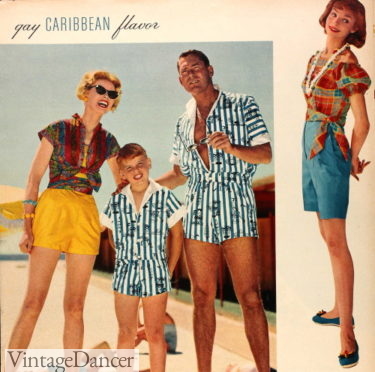
1958 Caribbean Summer Looks
Tailored shirts had one big drawback in the 1950s. Ironing! Starching! Cleaning! They required a lot of work to keep perfectly pressed and crisp as paper. To be wrinkled was mortifying!
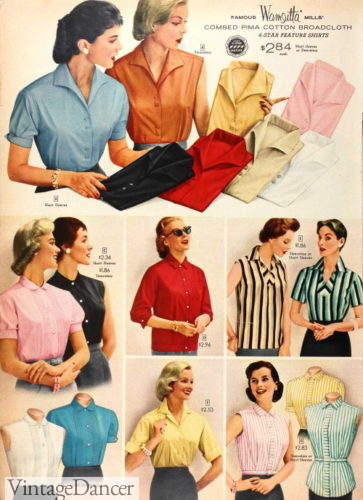
1957 Dressy and Casual Tailored Blouses
When nylon appeared in bright fun colors and new synthetics, like quick drying Dacron and Orlon, women bought them up in armfuls. They promised easier maintenance and less wrinkles, and it didn’t matter that these new synthetics didn’t breathe well or last as long as natural fibers. Cotton shirts were now the “old” or “poor person” thing to wear. Only new crisp synthetics were fashionable.
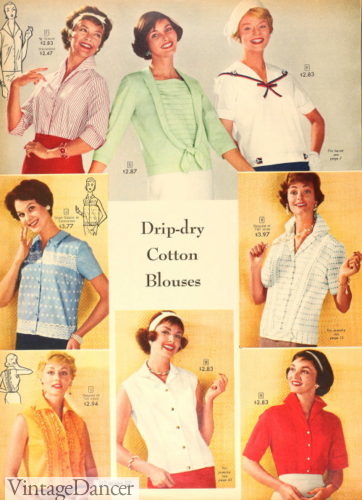
1959 “Drip Dry” Tops
To help keep blouses tucked in smoothly, wide elastic stays or small buttons buttoned to the inside of pants/skirts. It was a constant battle keeping blouses tucked in and an utter embarrassment when they popped out.
If there was one brand, one style of 50s blouse, it was the Ship ‘n Shore.
“The blouses typified the fifties sporty look- the finely pointed collar turned up to compliment an Italian haircut, maybe even with a button open at the neck. The working class dream was a closet filled with Ship ‘n Shore tops, all freshly starched and pressed. Every blouse could be worn with a black skirt and capris. Add white shorts in the summer for the sleeveless models. Simple and predictable.”- What We Wore
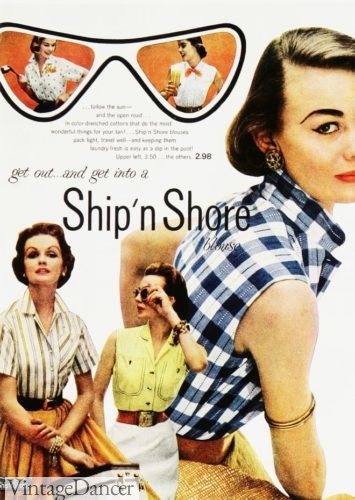
Great care had to be taken with Ship ‘ n Shore blouses. They needed frequent ironing and starching. Many women kept them in the refrigerator so they would be damp and ready for a hot iron in the morning. Dan River was another popular brand that advertiser their broadcloth cotton shirts (usually plaid) could be hung up to dry – no ironing needed.
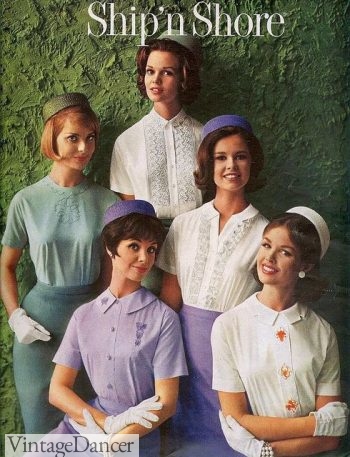
‘Ship ‘n Shore’ Blouses – A Popular Brand of Cotton Blend Shirts
1950s Blouse Collars
The variety of 1950s tailored tops were identified by the style of the shirt collar. Here are some of the common styles:
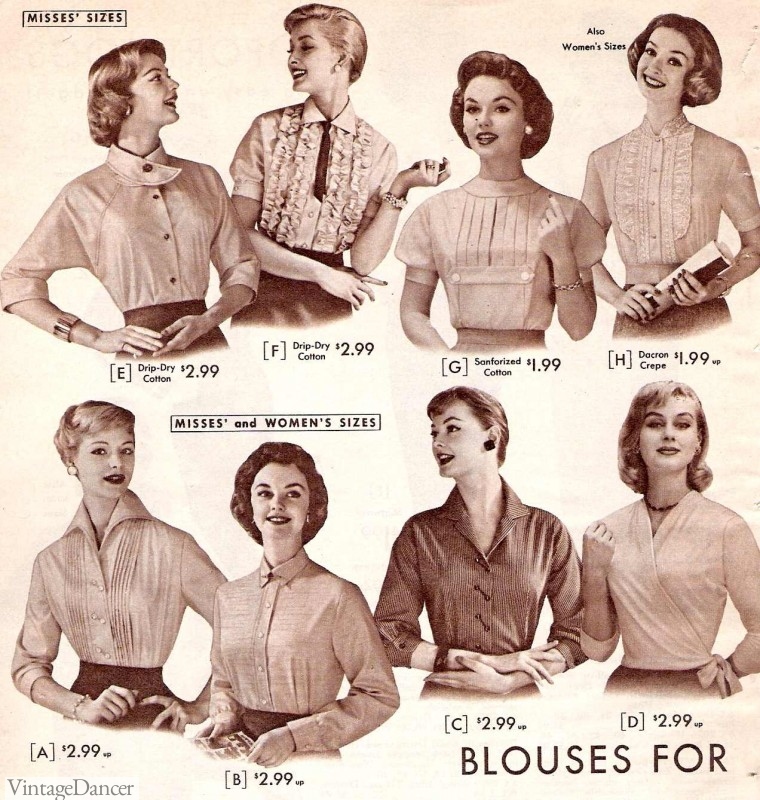
1957- A Variety of Blouses for Misses’ Sizes
Peter Pan collar – Small round collars perfect for layering under a sweater. They flipped out over the sweater and layered on top. Small and dainty, they were a softer alternative to the point collar. Also called Ivy League collars, they were often white with a contrasting body color. Many times, collars were sold separately and stitched into tops and sweaters, then tossed out once they looked worn. They must have taken history notes from the teens and ’20s, when men’s collars were sold detachable for the same reason.
- 1957 Tailored Peter Pan Collar Blouses
- 1958 Large Peter Pan Collar Overblouse
Detached or attached collars came in pique cotton (practical) and angora fur (long rabbit fur strands) that were soft and warm in winter. Some were accented with pearls and beads for a little more richness. A more youthful look had two little pompoms attached to the cords that tied in the front. The very wealthy could afford mink fur collars. They attached to warm sweaters and wool overcoats. So chic!
Classic collars – Pointed collars fastened to a small V neckline. They were often white, but pastels, plaids, checks and thin stripes were common, too. Shirt with this collar were the mostly tailored or menswear looking 1950s shirt. The Italian collar became a very popular alternative. It had a lifted collar with flared point out to the shoulders.
- 1956 Classic Blouse Collar
- 1956 Classic Blouse Collars
The portrait collar was an oversized point or round roll collar that peeled out around the neckline. It framed faces nicely and gave a regal, sophisticated look.
- 1951 Collar, Round Portrait Blouse
- 1957 Squared Neck, Collar and Bowtie Portrait Blouse
- 1958 Round Portrait Collar
Boat necks – The fancier French name for these was Bateau. They were large oval necklines, popular in knits that could be pulled overhead. The “Sabrina” Bateau had two bows on either shoulder. It was made popular by Audrey Hepburn, whose short-statured and simple gamine look appeared best in the style (hiding her skinny collarbone).
- 1957 Striped Bateau Boat Neck Shirt
- 1957 Sabrina Bateau Neck Top
Cowl collars were boat-shaped with gathers draped around the neck and shoulders. They were a winter favorite in wool jersey and other soft medium-weight fabrics.
- 1956 Cowl Neck Satin Top
- 1959 Cowl Neck Pullover Top
Party blouses – Not all tops were for casual wear. Formal sheer chiffon, light silk or satin, and embroidered eyelet were just a few materials made into party blouses. The blouse style could be tailored or peasant with exaggerated necklines, collars, and sleeves. Paired with a black pencil skirt or velvet swing skirt, the blouse was ready for an elegant cocktail party.
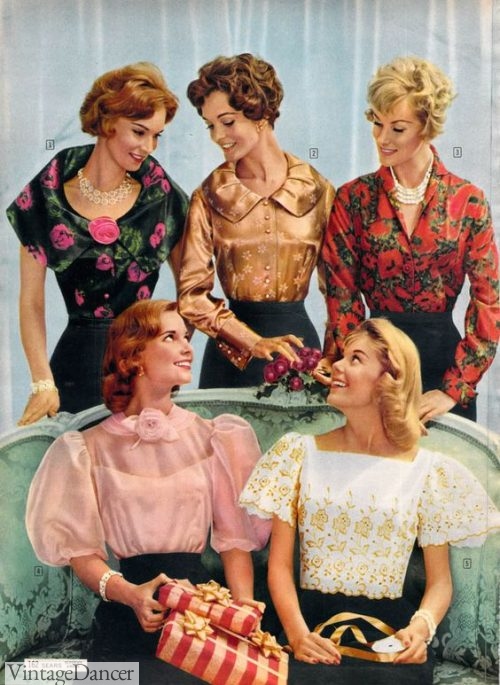
1959 Fancy blouses – Tailored and Peasant Style Party Blouses
Other unique collars:
- 1957 Bow Tie Blouse with Empire Bust
- 1957 Bow Tie Blouse
- 1957 Tab Neck Collar Blouse
- 1957 Scarf Tie or Neckerchief Collar
- 1957 Wrap Top
- 1957 Jewel Collar
1950s Summer Tops
Just like men’s shirts, women’s tops buttoned up the center. They were conservative, never opening enough to show any cleavage, and were worn tucked into pants and skirts to prevent midriff from showing. Most summer blouses were short or sleeveless tailored blouses.
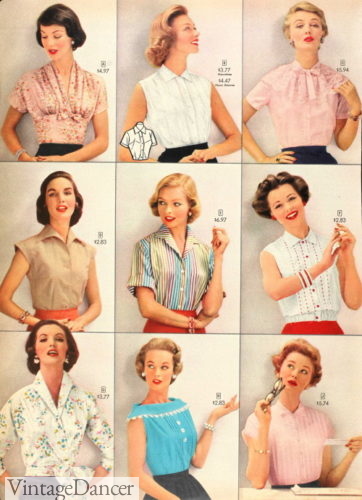
1957 Sleeveless Summer Blouses
The exception was the sleeveless tie front top that came out in summer. They were not worn tucked in, but they were always worn over high waisted bottoms. A little bit of a midriff was acceptable as long as it was a few inches over the belly button and below the ribs. Anything lower (or higher) was immoral.
The over-the-belly-button height of skirts, pants, and shorts meant tops were quite short compared to today’s longer styles. Keep this in mind when wearing vintage tops with modern bottoms.
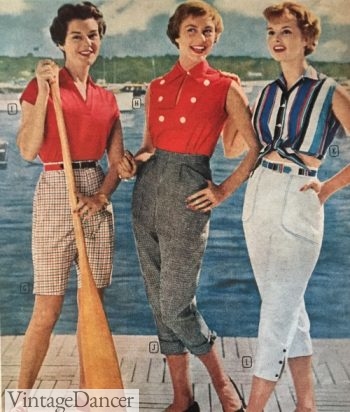
1950s Summer Outfits
- 1957 T-Shirt Crop Top
- Halter crop top with skirt
With a lack of air conditioning available, women had to dress to keep cool in summer. Sleeveless blouses with large armholes, halternecks, and deep scoop neck pullover tops were ideal summer tops.
- 1955 Round Neck Sleeveless Top
- 1955 Shoulder Ties Sleeveless Top
Halter blouses were another summer ‘50s top. These often came in loud floral prints or checks in bold colors. They could have two thick straps that tied or slid behind the neck with a zipper down the back. Some, like the one on the left, had very low backs. “Modest in front, immodest in back” was acceptable.
Other styles were the bra top style, worn with matching shorts.
- 1953 Zip-Front Halter Top
- 1954 Halter Top
- 1957 Halter Bra Top Worn With Matching Shorts
Peasant top – Bohemian chic tops with gathered necklines, puffy sleeves, and folk embroidery made the peasant top unique. They were common in the 1940s, too. ’50s versions took on Mexican Riviera and Italian seaside style with trims of rick rack, pom poms, embroidery, and Aztec art influences.
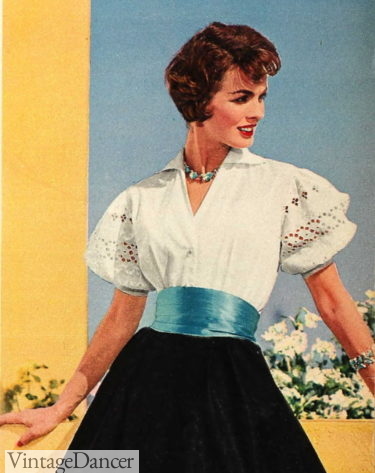
1958 Puff Sleeve Peasant Blouse
The 1950s version of a men’s Hawaiian shirt is the women’s Tea Timer shirt. It was traditionally made of silk and sleeveless or cap-sleeved with a Mandarin collar. They came in Hawaiian or tropical themed prints with 5 wooden or coconut buttons, side slits, and pockets on the front. They could be worn buttoned up as a shirt, or open as a casual overshirt. They were usually worn with Capri pants or a skirt as a summer outfit. You can still find some great vintage Tea Timer shirts on Etsy.
1950s Knit Tops
Tailored blouses were not the only common style of top. The short sleeve snug fitting pullover knit top was a cousin of the sweater.
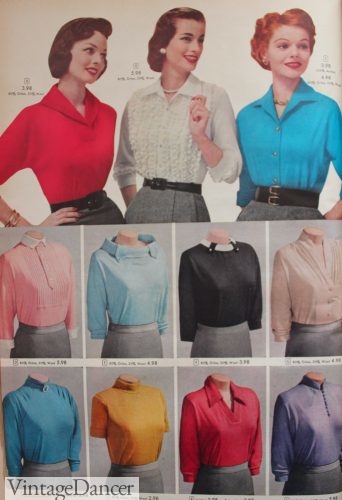
1957 Knit Tops and Tailored Blouses
New materials reduced the bulk of previous generations of sweaters, as well as making them shrink proof. Thin knit tops could have a traditional tailored point or Peter Pan collars, but were more often seen in high crew necks, roll necks, shawl collars, and boat necks. Sometimes, the V-neck versions with point or shawl collars were called polo shirts.
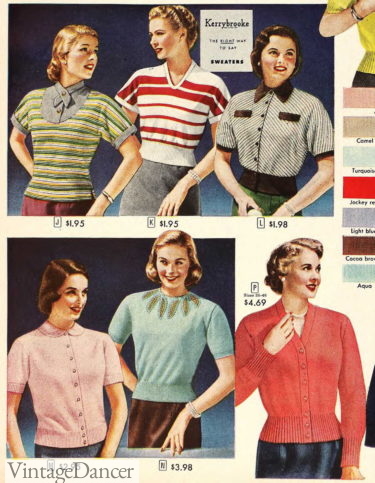
1952 Knit Short Sleeve Sweater Tops
The summer knit tops were usually plain colors, not patterns. Some did feature knit-in designs or textures as alternatives to the smooth finish on most knit shirts. Sleeve lengths were short, mid-arm lengths, or longer dolman sleeves.
- 1952 Dolman Sleeve Top
- 1957 Polo Style Top
- 1957 Mock Neck Top
The bottom of the knit top had a wide waist band. They could be worn tucked into skirts and pants or worn over them. Tucked in was more sleek looking, while untucked was more casual.
- 1957 Knitwear Tops
- 1957 Knitwear Tops
One popular trend was to wear a short chiffon scarf, rolled and tied to the left around the neck. These colorful neck scarves were almost always worn with a tight knit top. The pop of color was yet another way of accessorizing an outfit.
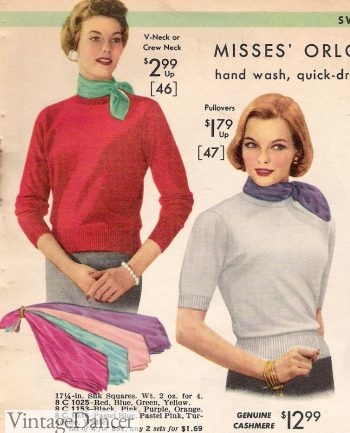
1957 Neck Scarf
Even in winter, knit tops were usually worn alone, not over another blouse. This helped reduce bulk and keep the wasp waist effect popular in 1950s fashion.
Read More
- 1960s Women’s Tops, Shirts, and Blouse Styles
- 1940s Women’s Blouses and Button Ups
- Vintage Women’s Sweater History: 1940s-1960s
- 1950s Women’s Shorts Styles
- 1950s Skirts History
1950s Style Tops
1950s reproduction or new vintage inspired 1950s tops tend to favor a few youthful styles such as the halter top, the peasant top, the Peter Pan collar, knit tops, and spaghetti strap tops like these:
Debbie Sessions has been teaching fashion history and helping people dress for vintage themed events since 2009. She has turned a hobby into VintageDancer.com with hundreds of well researched articles and hand picked links to vintage inspired clothing online. She aims to make dressing accurately (or not) an affordable option for all. Oh, and she dances too.
